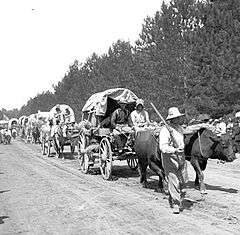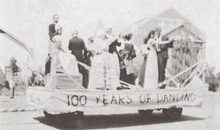Pioneer Day (Utah)
| Pioneer Day | |
|---|---|
 Re-enactment of Mormon pioneers in the 1912 Pioneer Day Parade at Liberty Park, Salt Lake City, Utah | |
| Observed by | Utah, United States |
| Significance | commemorates the entry of Brigham Young and the first group of Mormon pioneers into the Salt Lake Valley on July 24, 1847 |
| Celebrations | parades, fireworks, rodeos, and other festivities |
| Date | July 24 |
| Next time | July 24, 2017 |
| Frequency | annual |
Pioneer Day is an official holiday celebrated on July 24 in the U.S. state of Utah,[1] with some celebrations in regions of surrounding states originally settled by Mormon pioneers.[2][3] It commemorates the entry of Brigham Young and the first group of Mormon pioneers into the Salt Lake Valley on July 24, 1847,[4] where the Latter-day Saints settled after being forced from Nauvoo, Illinois,[5] and other locations in the eastern United States.[6] Parades, fireworks, rodeos, and other festivities help commemorate the event. Similar to July 4, most governmental offices[1] and many businesses are closed on Pioneer Day.[7]
In addition to being an official holiday in Utah, Pioneer Day is considered a special occasion by many members of The Church of Jesus Christ of Latter-day Saints (LDS Church).[8][9] On Pioneer Day, some Latter-day Saints walk portions of the Mormon Trail or reenact entering the Salt Lake Valley by handcart.[10] Latter-day Saints throughout the United States[11][12] and around the world may celebrate July 24 in remembrance of the LDS Church's pioneer era, with songs, dances, potlucks, and pioneer related activities.[13][14]
While the holiday has strong links to the LDS Church, it is officially a celebration of everyone, regardless of faith and nationality, who emigrated to the Salt Lake Valley during the pioneer era, which is generally considered to have ended with the 1869 arrival of the transcontinental railroad.[15] Notable non-LDS American pioneers from this period include Episcopal Bishop Daniel S. Tuttle, who was responsible for Utah's first non-Mormon schools (Rowland Hall-St. Mark's) and first public hospital (St. Mark's) in the late 1800s.[16] The Intertribal Powwow at Liberty Park in Salt Lake City honors the rich cultural heritage and contributions of the area's Native Americans, helping Utahns to gain a deeper understanding of the region's history.[17][18]
History
%2C_1832-1909.jpg)
The earliest precursor to Pioneer Day celebrations in Utah occurred on July 24, 1849,[19] when the Nauvoo Brass Band led a commemoration of the second anniversary of the Latter-day Saints entering the Salt Lake Valley.[20]
The first celebration of Pioneer Day in 1857 was interrupted with news of the approach of Johnston's Army, heralding the beginning of the Utah War.[21] During the following occupation of the Utah Territory by federal troops, Pioneer Day was not celebrated.[22] Once President Abraham Lincoln initiated a hands-off policy on Utah in 1862 during the American Civil War[23] Pioneer Day was once again observed, and expanded into the surrounding areas as the Mormon Corridor spread throughout the Intermountain West.[22] In 1880, Latter-day Saints commemorated the Golden Jubilee of the church's formal organization in 1830; tens of thousands of people in hundreds of communities participated in very enthusiastic festivities.[22]
In the years that followed, federal enforcement efforts of anti-polygamy laws (including the 1882 Edmunds Act) resulted in greatly subdued celebrations.[22] The 1886 commemoration was particularly notable for its mourning theme, with the Salt Lake Tabernacle decorated in black instead of the usually colorful bunting, and the eulogizing of Latter-day Saints who were in hiding or imprisoned for polygamy offenses.[22] By 1897, the celebration included not only the 50th anniversary of the initial arrival in the Salt Lake Valley, but also the end of the polygamy issue, the completion of the Salt Lake Temple, and statehood for Utah.[22]
The centennial in 1947 and the sesquicentennial in 1997 were especially large celebrations in Utah. One writer indicated that the 1947 celebrations seemed to incorporate the entire year, with July 24 only being an apex to the events.[24]
The holiday generates a great deal of road traffic; Utah Department of Public Safety statistics demonstrate that Pioneer Day has the second highest holiday traffic fatality rate in Utah, with the earlier July 4 Independence Day having the highest rate.[25]
The holiday has received criticism for its lack of inclusiveness for non-Mormons.[26]
Related events

- Salt Lake City celebrates with fireworks and the "Days of '47 Parade".
- Bountiful, Utah, celebrates with fireworks and a parade at "Handcart Days".
- Spanish Fork, Utah, celebrates with "Fiesta Days".
- Manassa, Colorado, celebrates Pioneer Days on the weekend closest to July 24.
- Panaca, Nevada, celebrates Pioneer Day on the Saturday closest to July 24.[27]
- Luna, New Mexico, celebrates "Mormon Pioneer Day" on the Saturday closest to July 24 at the village rodeo grounds with a parade, rodeo and dance
- St. Anthony, Idaho, celebrates the annual Fremont County Pioneer Days celebration on the weekend closest to July 24.[28]
- Stirling, Alberta, Canada, celebrates Stirling Settler Days in the third week of July.
- With historical ties to Utah and the LDS Church, La'ie Days is celebrated during the month of July in Laie, Hawaii, often with pioneer themes.
- Pie and Beer Day: an alternative celebration themed around food and drink pairings, primarily for non-Mormons.[29][30][31]
See also
Notes
- 1 2 Utah Code 63G-1-301 (Legal holidays), Utah State Legislature, retrieved 2013-08-05
- ↑ Packard, David (15 July 2009), "Pioneer Day in Pocatello, Idaho", Church News, LDS Church, retrieved 2013-08-05
- ↑ Tanner, Eliza (September 1995), "Safe from the Storms", Ensign, LDS Church
- ↑ Schindler, Harold (24 July 1997), "Ailing Young Rolls Out of Canyon, Likes Look of the Salt Lake Valley", Salt Lake Tribune, Mormon Trail Series, Article ID: 100F84BB82E32C16. Reprinted with permission at Utah History to Go.
- ↑ Sanford, Melissa (8 April 2004). "Illinois Tells Mormons It Regrets Expulsion". The New York Times.
- ↑ "Today in History: July 24", American Memory, Library of Congress, retrieved 2013-08-05
- ↑ Nii, Jenifer K. (July 22, 2004), "Businesses are taking varied approaches to weekend Pioneer Day", Deseret News
- ↑ Hinckley, Gordon B. (October 2001), "Remarks at Pioneer Day Commemoration Concert", Ensign, LDS Church
- ↑ Reynolds, Sydney Smith (June 1989), "They Belong to Us All", Liahona, LDS Church
- ↑ "Mormons Celebrate Their Pioneer Heritage", Newsroom, LDS Church, retrieved 2013-08-05
- ↑ McGrath, Rachel (26 July 2009), "Mormons in Camarillo mark pioneers' Utah arrival in 1847", Ventura County Star, Camarillo, California, archived from the original on 2012-08-06
- ↑ Rohrer, Grey (20 July 2009), "Pioneer Days celebrate western migration", Cape Coral Daily Breeze, Cape Coral, Florida, retrieved 2013-08-05
- ↑ Gaunt, LaRene Porter (April 2005), "Celebrate!", Ensign, LDS Church
- ↑ Bailey, Tamara Leatham (July 1997), "For Your Info: Pioneer Parties", New Era, LDS Church
- ↑ Greenleigh, Alicia (21 July 2009), "Days of '47: The day when pioneers are cool", Salt Lake Tribune, retrieved 2013-08-05
- ↑ Quinn, Frederick (2004), "Chapter 1: Daniel S. Tuttle, the pioneer bishop", Building the "Goodly Fellowship of Faith" - A History of the Episcopal Church in Utah - 1867-1996, Logan, Utah: Utah State University Press, ISBN 0874215935, OCLC 56347804
- ↑ Mayorga, Carlos (2008-07-20), "Powwow honors Indian culture", The Salt Lake Tribune, pp. D3, retrieved 2013-08-05. Archive Article ID: 9925806
- ↑ Wharton, Tom (2011-07-26), "American Indians celebrate culture at Liberty Park", The Salt Lake Tribune, retrieved 2013-08-05
- ↑ Olsen, Steven L. (1996), "Celebrating Cultural Identity: Pioneer Day in Nineteenth-Century Mormonism", BYU Studies, 36 (1): 159–177
- ↑ Purdy, William E. (July 1980), "They Marched Their Way West: The Nauvoo Brass Band", Ensign, LDS Church.
- ↑ "The First Statewide Pioneer Day Celebration", Markers and Monuments Database, Utah Division of State History, Utah Department of Heritage & Arts, retrieved 2013-08-05
- 1 2 3 4 5 6 "Pioneer Day", Utah History Encyclopedia, University of Utah Press, 1994, retrieved 2013-08-05
- ↑ Firmage, Edwin Brown; Mangrum, Richard Collin (2001), Zion in the Courts, University of Illinois Press, p. 139, ISBN 0-252-06980-3,
Having signed the Morrill Act, Abraham Lincoln reportedly compared the LDS Church to a log he had encountered as a farmer that was "too hard to split, too wet to burn and too heavy to move, so we plow around it. That's what I intend to do with the Mormons. You go back and tell Brigham Young that if he will let me alone, I will let him alone."
- ↑ Haddock, Marc (20 July 2009), "Celebrating Pioneer Day in 1947", Deseret News, retrieved 2013-08-05
- ↑ Holiday Deaths (Utah 1999-2008) (PDF), Utah Department of Public Safety, retrieved 2013-08-05
- ↑ Means, Sean P. (July 23, 2015), "Pioneer Day should reflect all of Utah's people", The Salt Lake Tribune
- ↑ Velotta, Richard N. (July 23, 2014). "Panaca shares sesquicentennial with Nevada". Las Vegas Review-Journal. Retrieved 2014-07-23.
- ↑ "Pioneer Days - Something for everyone", fremontpioneerdays.com, retrieved 2013-08-05
- ↑ Dobner, Jennifer (July 24, 2014), "Pioneer Day of Mormons, Retooled for Saloon", The New York Times
- ↑ Stephenson, Kathy (July 21, 2015), "Pie and Beer Day an alternative to Utah's traditional Mormon holiday", The Salt Lake Tribune
- ↑ McCombs, Brady (July 24, 2015), "Non-Mormon faux holiday 'Pie and Beer Day' gains traction", AP.org, Associated Press, archived from the original on 2015-07-24
External links
 Media related to Pioneer Day (Utah) at Wikimedia Commons
Media related to Pioneer Day (Utah) at Wikimedia Commons